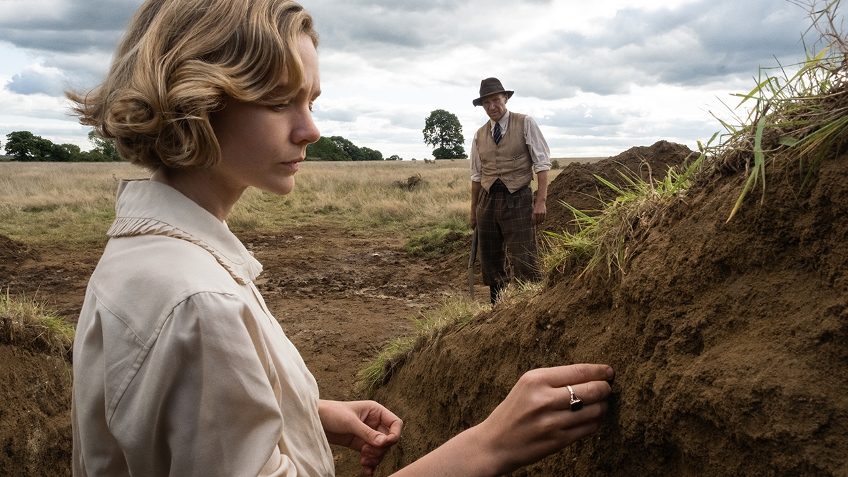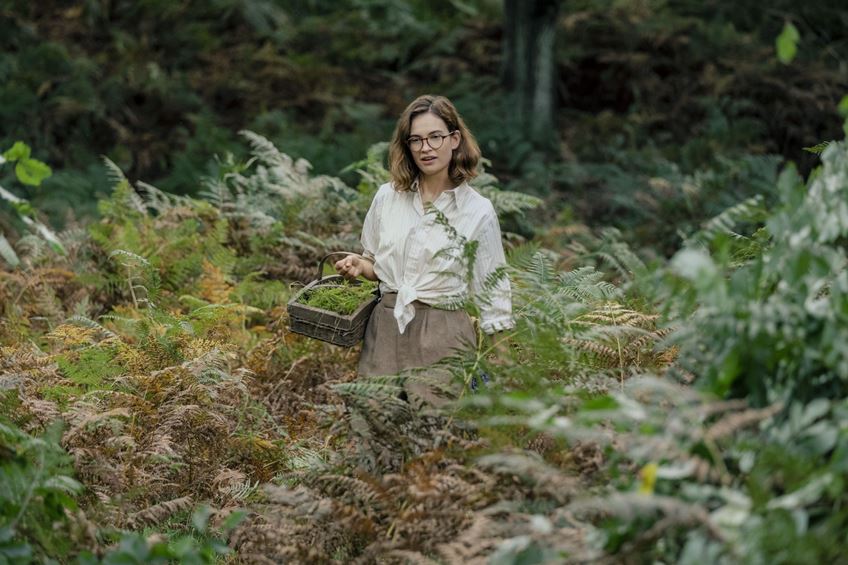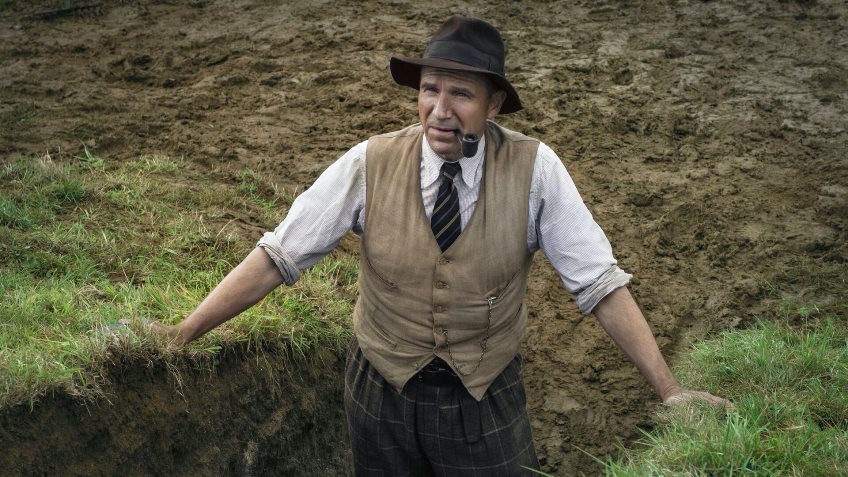The Dig (January 29, 2021) Cert 12A, 112 mins. Available on Netflix
With its cosmic themes of uncertainty, death, legacy, elitism and people making unlikely connections across gender and class divides, the release of The Dig feels timely. Although the Sutton Hoo treasure was discovered in 1939 and has long been in the British Museum, Australian director Simon Stone and script writer Moira Buffini, rightly believe that the uplifting and heart-breaking story behind its discovery is another treasure, buried for too long. It is a very good story, told by a stellar cast, but it is not the whole story; and for all its cinematographic and sound flourishes, it is too sedate and uninspired to be another dazzling treasure.
Edith Pretty (Carey Mulligan) is a thirty-something widow living with her young son in a stately home on a vast estate in Surrey. She and her beloved husband (a WWI veteran who died in the early 1930s) purchased Sutton Hoo with a view to excavating the curious mounds in the midst of otherwise flat Suffolk farmland. Perhaps sensing the rheumatic heart disease that is to end her life prematurely, she hires Basil Brown (Ralph Fiennes), recommended by the Ipswich Museum, to dig, and tells the dubious Brown that she has a hunch where they should start.
The relationship between the heavily accented Suffolk farmer’s son with a gruff, graceless and direct manner, and the elegant, well-travelled, cultivated, and affluent woman brings to mind the film Mrs. Brown, in which the strong-willed Queen Victoria (a grieving widow like Mrs Pretty) strikes up a platonic relationship with an equally strong-willed and wise-beyond-his-station working-class employee.

The comparison is even more apt if you consider that, in reality, Mrs Pretty was, at the time of the dig, 58 or 59, just a few years older than Basil Brown. It is just a shame that the chemistry between Mulligan and Fiennes does not match that between Judi Dench and Billy Connolly in Mrs Brown.
Mrs. Pretty and Mr Brown (as they address one another) discover common ground: both were forced to leave school early; Brown, at age 12, to farm the fields with his father and Mrs Pretty because only the men in the family went to university. And both are explorers. Self-educated in archaeology, astronomy and geography through books, correspondence courses and a lifelong obsession with digging up Suffolk fields, Brown modestly claims he is not an archaeologist, but an excavator.
The two bond in a low-key relationship that, refreshingly, is not a romance, although Mrs Pretty, clearly lonely for intelligent conversation, is visibly disappointed when Brown’s affable, big-hearted and understanding wife May (Monica Dolan) shows up to bring him clean shirts and he feels he must cancel their dinner together.
In a terrific scene, that bond is strengthened when the burial tomb structure collapses and Brown is buried by the soil he has dug. Fortunately, former-WWI nurse Mrs Pretty is there in a flash to dig him out and provide that mouth-to-mouth resuscitation that saves him.
When the “excavator” uncovers what was the shell of a huge Viking-like ship, the big guns from the Ipswich Museum and then the British Museum, show up to compete to take over the dig. Brown, who is proud despite his modesty, spends a lot of the film sulking and threatening to leave the dig; first over wages (Mrs Pretty capitulates) and then on several occasions when his contribution is questioned. It is for Mrs Pretty to champion him. Villain is too strong a word, but the big threat comes from the arrival of Charles Phillips (Ken Stott) from the British Museum who wants Brown and the farm-hand helpers to clear out and leave it to the professionals.
The tension is exacerbated when Brown is convinced a coin they find is from the 6th century. Phillips rejects the idea: there was not a coin-based economy in the region until the 9th century. But on closer inspection, the coin proves to be Anglo-Saxon, and Phillips has egg on his face. It makes for great drama, particularly when Phillips declares, “These people weren’t marauders; they had culture, art, money!”
The Dig makes it clear: this is the treasure that changed the textbooks on the history of our nation, even if we do not see much of the treasure in the film (in fairness, most of it was uncovered in the decades after the war). The Dig also gives due credit to the side-lined Basil Brown (who, despite Mrs Pretty’s wish, was not at first credited with the discovery), and goes some way toward recognising the importance of Edith Pretty and another important woman, Peggy Preston Piggott.

For Phillips arrives on the scene with archaeologist Stuart Piggott (Ben Chaplin), recently married to the recently graduated archaeologist Peggy (Lily James). Although Peggy endures sexists remarks from Phillips and pats on the head from her much older husband (dramatic licence), it is Peggy (the aunt of John Preston, the author of the book on which the film is based) who finds the first piece of treasure.
Someone, however, decided a hot romance was needed, and so Peggy is portrayed as an Effie Gray to Stuart Piggott’s John Ruskin in an unconsummated marriage that leaves her hot for Mrs Pretty’s flirtatious and manly, but fictitious cousin, Rory (Johnny Flynn). Rory’s purpose is not only to provide the romance that will give Peggy the courage to ask for a divorce (in fact, the Piggotts’ marriage lasted 18 years) but, since Rory enlists in the RAF, his character draws our attention to the sense of foreboding and time, as the dig is taking place under low flying planes.
That Brown believes the ship was an elaborate burial chamber for an important East Anglian warrior (not everyone is buried with a magnificent helmet and jewelled buckles in a heavy ship dragged across land from the River Deben) serves as a nice metaphor for all the brave pilots whose bodies were never found.
Rory is also the dig photographer, and this dramatic licence deprives the film with two more ladies who, together with Peggy and Edith could have shaped history into a narrative in which a self-educated farmer’s son and four women (not identified as love interests) are the heroes of Sutton Hoo. A marvellous subplot, far more unusual than the Rory subplot, might have centred around the two women who, according to Mr Stone, showed up and persuaded Mrs Pretty to let them stay on the estate and chronicle the dig with their camera.
You can read our review on the film Effie Gray by following this link.




